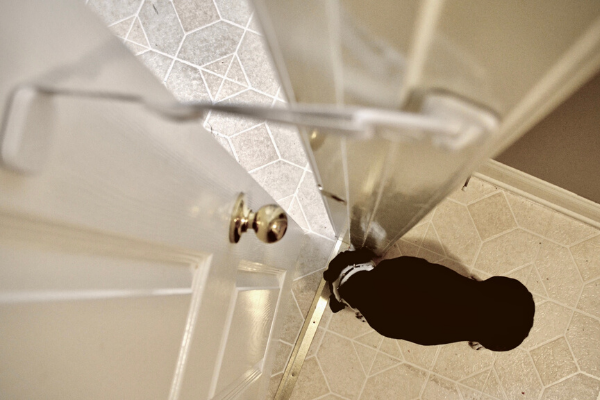|
I help children overcome their fear of water with a dose of compassion and a whole lot of patience.
|
Pet Doors: Are Any of Them Childproof? Let’s find out.
So I was thinking about all the ways young children can escape from their homes. And then I thought, “I bet pet doors pose a problem.” So I started to do some research on the subject.
(This post contains affiliate links. This means if you click on an affiliate link and purchase the item, we will receive an affiliate commission at no extra cost to you. Full disclaimer.)

I found some parents in forums asking if they should be concerned about installing a pet door. “Will my child be able to escape through it?”
Some parents replied with “I never had any problems. My kids never tried to get through it,” Leaving the concerned parent with a false sense of security.
I probably would’ve replied with the same lack of concern back in the day, since my son never tried to get out of the house. It was just not part of his nature.
The other day, I was speaking on the phone with one of the mother’s (let’s call her Susan) of one of my students (let’s call him Albert since I enjoy coming up with names that parents today would never name their child).
In the middle of the conversation, Albert tried to escape through the pet door. Susan responded, and I paraphrase, “you know you’re not allowed through the doggie door! Get back in here!”
I thought to myself, “Wow! This pet door thing is a real issue.”
Susan shared with me that a few months ago, Albert’s grandparents bought him a trampoline designed for toddlers/preschoolers. Well, naturally this was the best gift ever to Albert.
So the trampoline was placed in the backyard. Well, one day, Albert went missing for a moment or two. Within minutes Susan and her husband discovered him outside on the trampoline. He had escaped through the pet door.
Thank goodness they found him right away and no worse for wear. And also lucky that he was jumping on the trampoline and not into the swimming pool.
Tovah Klein, Ph.D., director of the Barnard College Center for Toddler Development says that bolting from a parent’s side is a toddler’s way of exploring his independence. “Starting around 18 months, toddlers suddenly realize, ‘I’m my own person,'” Dr. Klein says. So they’re eager to get out of the stroller and check out the world on their own. “They don’t understand that when they run off, adults can’t necessarily see or protect them,” she explains.
Did this particular sentence have an impact on you, as it did with me? “THEY don’t understand that when they run off, adults can’t necessarily see or protect them.” This quote struck a chord with me.
So in other words, toddlers think that their parents are just these magical beings. They must feel so secure all the time. It doesn’t matter what they do; they believe that they will always be safe.
From the Calgary Herald: Last summer, Krista Teare said she was baffled to find lawn sprinklers nestled in bed beside her sleeping son Declan in their Garrison Green home.
And from right here in the desert: A mother of two of my students told me the other day that her son has been able to crack the code of every type of doorknob and childproof doorknob known to man. There is nothing that won’t hold him back.
Scientists today are still analyzing the intricate workings of the toddler/preschooler brain in the hopes of designing the perfect childproof doorknob. Because when little kids want to get through a door, they will find a way.
As you can see from this Facebook thread: Even an electronic smart door for pets can’t outsmart a toddler.

Their primary purpose is to keep other neighborhood pets and critters out of your house.
So if your child does escape through the smart door pet door, there’s a good chance that he will not be able to get back in.
Here’s what I found from the Safety Research and Strategies website:
This is what I found on the interwebs 😃 for toddler monitor type devices that you might find interesting of which I have no affiliation. I felt like I needed to let you know that:
But unfortunately, I didn’t find any devices that are explicitly designed to prevent your child from escaping through a pet door. The closest gadget to contain your little escape artist would be a door sensor, but then it’s going to sound an alarm every time your pet exits and enters your home.
And if you want to hear a 120-decibel alarm going off every time your beloved furry family member uses the pet door, then maybe that would be a good option for you.
But for the rest of us, that would get a little tiresome after awhile. Correction. Instantaneously. I don’t think your dog or cat would appreciate it either.
Although, it would be fun to witness their reaction. Just one time. Okay, two or three times. Five or six tops. No more than ten times. Then it’s just cruel. 😃 Kidding! But seriously, the video WOULD go viral. Just sayin’.
So if you have a pool, please consider installing a fence (climb-resistant mesh fence is best) around your pool, if you haven’t already.
And even if you do have a fence, close supervision is still essential. Children will find creative ways to scale it. Remove any structures that gain access to the pool. Some structures include but are not limited to outdoor furniture, climbable trees, decorative walls and playground equipment.
And if your children often visit friends and or relatives with a pool, please encourage them also to fence it in.
Do the same for other water sources, such as spas and landscae water features.

If you are ok with keeping your pets (and of course your child) inside at night, a safer alternative is to forego the pet door altogether and keep your doors closed and locked at night. During the day, you can use a childproof door latch like this one by Door Buddy. It is an adjustable door strap that fits onto your door and frame -out of reach from your child’s busy fingers. An added bonus is that you can set it to the perfect width to let your cat (and small dog) in and out while stopping your child from following. You can also opt to get the one with the door stopper. This combo will prevent your child from closing the door and locking your cat in or out. Plus, it helps keep little fingers safe.
Drowning is also easily preventable. And one of the most important and easiest ways to keep your children safe is to erect barriers around your pool, spa, and landscape water features.
…So that your kids don’t wander out into the street.
The mother of the master doorknob hacker had a story about that too. Her friends (parents of a toddler) both had to call in sick one day from work. They ended up falling asleep at the same time. Upon awakening, their child was nowhere in sight. Fortunately, they found her on the sidewalk without delay or harm.
Maybe a fenced-in yard would’ve kept her off of the sidewalk and away from the street.
You can’t take your eyes off of your kiddo for even a second because they’re likely to try to escape and no gadgets or devices currently on the market are 100% effective.
If so, what do you do to keep them safe? I would love to know how you handle this dilemma.
Any suggestions or thoughts on the subject that might be helpful to our readers would be much appreciated. Because it’s entirely possible that I missed something relevant and maybe you can enlighten us.
I look forward to hearing from you with your brilliant ideas.
Love the water but fence it in, pet doors
Tessa pet doors
P.S. Get the FREE water safety app to help ensure your family stays safe in, on and around the water. It includes kid-friendly videos and quizzes. Search the iTunes app store for Swim by American Red Cross or click here. For Google Play you can use the same search parameters or click here. It provides the latest in water safety guidance to help ensure your family stays safe in, on and around the water.
P.P.S. To start your child on the path to becoming water safe, click here.
do you have a fearless child?

Ahhhh!!!! The holidays are approaching so fast. I have a gazillion things to do to prepare for a gazillion visitors. And I have done nothing! I tell you, nothing! Also, my son will be returning from college. I can’t wait! It’s been so long. Enough about me.
If you are a reader of my blog, then you know that I have devoted a lot of time to helping children overcome their fear of water. But what about the child who has no fear. The fearless child. Always putting himself in harm’s way and not considering the outcome. This child is at an even higher risk of drowning than the fearful one.
Check out these great tips on parenting the fearless child.
She told me that her son, five years old wanted to show her “his skills.” And, yes, she did include the air quotes when speaking of “his skills.”
So, here’s what happened. During a visit to a friend’s house, the five-year-old, let’s call him Johnny, ripped off his water wings and stepped into the inground spa (not heated to the typical hot tub temperature).
Now standing on the seat and with the intent to make it to the other side, he leapt into the middle with all the confidence one can muster. In an instant, with limbs akimbo, (I bet you never saw that coming) and with his mother on the sidelines rooting him on, he did make it to the other side.
His mom said that the incident made him more aware of the fact that maybe he doesn’t have the “skills.” It’s a lesson that Johnny will not soon forget. And as a result, he’s much more cautious when he’s around water. Mission accomplished because isn’t that precisely what we all want from our children?
So give your children the opportunity to learn from their mistakes and let them experience the natural consequences (as long as it’s not too dangerous). It makes more of an impact and tends to leave a long-lasting impression.
Did you know that the prefrontal cortex (decision making, problem-solving and moderating social behavior part of the brain) isn’t fully developed until about age 25 or so? For more on this, be sure to check out my blog post entitled When Will My Child Ever Learn?
In the meantime between now and when they celebrate their 25th birthday, you’ll just need to continue to help them make better choices.
And be sure to continually remind them to stay away from water hazards, wear life jackets, stay close to adults, never swim alone, and the list goes on because they WILL forget.
Also consider fencing in your pool, spa and or landscape water features. Children ages 1-4 years most often drown in home pools, simply because there are no barriers.
If you have any thoughts on the subject or experiences that you would like to share about your fearless kiddo, I would love to hear from you.
Love the water but fence it in, do you have a fearless child
Tessa do you have a fearless child
P.S. Get the FREE water safety app to help ensure your family stays safe in, on and around the water. It includes kid-friendly videos and quizzes. Search the iTunes app store for Swim by American Red Cross or click here. For Google Play you can use the same search parameters or click here. It provides the latest in water safety guidance to help ensure your family stays safe in, on and around the water.
P.P.S. To start your child on the path to becoming water safe, click here. do you have a fearless child


Hello everyone. I hope you all had a wonderful Thanksgiving. I know, it’s been a long time. The summer was crazy busy, so I had no time to write, but I’m back.
I just uploaded a new blog post
It’s all about swim diapers. Everything you wanted to know and more. In case you thought that you wanted to know a whole lot about swim diapers, then you’ve come to the right place. It also includes a swim diaper hack video. You’ll want to check it out. It’s a real time saver.
This just happened http://www.latimes.com/local/lanow/la-me-ln-north-hollywood-drowning-20171130-story.html. Don’t let it happen to your little ones. Did you know that any water deep enough to cover the mouth and nose, which can be less than two inches, can cause drowning?
Also to prevent accidents from happening, provide close adult supervision. Furthermore, be sure to empty all buckets of water, close bathroom doors, use safety locks on toilets, never leave a child unattended in a bathtub, drain the tub and sinks and empty kiddie pools.
And finally, include barriers around swimming pools, spas, and water features.
No matter how well your child can swim and no matter how shallow the water is, always, always provide constant and vigilant adult supervision.
If you have any thoughts on the subject or experiences that you would like to share, I would love to hear from you.
Love the water but fence it in,
Tessa
P.S. Get the FREE water safety app to help ensure your family stays safe in, on and around the water. It includes kid-friendly videos and quizzes. Search the iTunes app store for Swim by American Red Cross or click here. For Google Play you can use the same search parameters or click here. It provides the latest in water safety guidance to help ensure your family stays safe in, on and around the water.
P.P.S. To start your child on the path to becoming water safe, click here.
